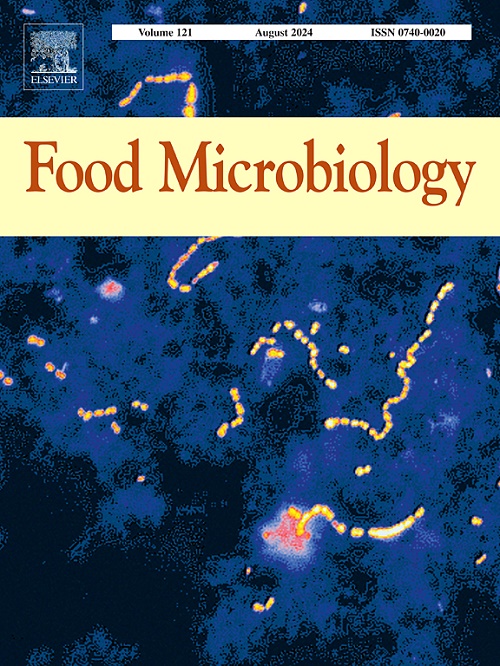日本裂糖酵母菌、酿酒酵母菌和芽孢杆菌混合培养发酵提高赤霞珠葡萄酒果香
IF 4.6
1区 农林科学
Q1 BIOTECHNOLOGY & APPLIED MICROBIOLOGY
引用次数: 0
摘要
据报道,酿酒酵母菌和非酿酒酵母菌的混合培养发酵带来了更高多样性的挥发性化合物,并可能为葡萄酒带来更大的芳香复杂性。本研究主要对从贵州本地葡萄中分离出的具有高耐受性和良好发酵特性的具有杀伤活性的酿酒酵母FBKL2.9126、具有良好发酵特性的强絮凝性菌株日本裂糖酵母FBKL2.9SZJ-29、高果胶酶形成性菌株Starmerella bacillaris FBKL2.91505进行了性能研究。首先通过分析粳稻各阶段不同细胞形态的比例,确定了粳稻的整个生长周期。将日本血吸虫的生长周期分为生长、分裂、产孢和孢子释放四个阶段。进一步设计3对引物,对含有179For375Rev、179For388Rev和388For518Rev的日本血吸虫进行特异性扩增,并建立相应的定量PCR (qPCR)标准曲线。最后采用三种接种方式对赤霞珠进行葡萄酒发酵,分别为酿酒葡萄球菌纯发酵、酿酒葡萄球菌与日本葡萄球菌混合培养发酵、酿酒葡萄球菌与日本葡萄球菌混合培养发酵并提前12 h接种芽胞杆菌。采用qPCR、平板电泳和细胞计数等方法对酿酒酵母、芽胞杆菌和日本链球菌在葡萄酒发酵过程中的数量进行了研究。两种非酵母菌在发酵过程中均保持106 ~ 107个细胞/mL的浓度。oav1与酿酒酵母共接种可提高风味物质乙酸异戊酯的含量。感官分析表明,提前接种芽胞杆菌12 h的混合培养发酵使赤霞珠葡萄酒的果香比其他两种发酵方式更浓,且显著提高了酒中己酸乙酯(OAV>1)和乙酸己酯等果香物质的含量。而相关分析则强调了酿酒酵母数量变化对相关挥发性物质含量变化的影响。本研究通过混合培养发酵,探讨了日本弧菌和芽胞杆菌对赤霞珠葡萄酒风味的影响,为发酵过程中日本弧菌的定量测定提供参考。本文章由计算机程序翻译,如有差异,请以英文原文为准。

Enhancing fruity aroma of Cabernet Sauvignon wine by mixed culture fermentation with Schizosaccharomyces japonicus, Saccharomyces cerevisiae, and Starmerella bacillaris
The mixed culture fermentation of Saccharomyces cerevisiae and non-Saccharomyces yeast has been reported to bring a higher diversity of volatile compounds and presumably a greater aromatic complexity to wine. This study mainly focuses on the performance of specific indigenous yeasts isolated from local grapes in Guizhou, including killer active S. cerevisiae FBKL2.9126 with high tolerance and good fermentation trait, strong flocculation strain Schizosaccharomyces japonicus FBKL2.9SZJ-29 with good fermentation trait, and high pectinase formation strain Starmerella bacillaris FBKL2.91505. The entire growth cycle of S. japonicus was firstly determined by analyzing the proportions of different cell morphologies of S. japonicus at various stages. Four stages including growth, division, sporulation, and spore release, were defined in the growth cycle of S. japonicus. Three primer pairs were further designed for specific amplification of S. japonicus containing 179For375Rev, 179For388Rev, and 388For518Rev, and were used for the establishment of corresponding quantitative PCR (qPCR) standard curves. Wine fermentations of Cabernet Sauvignon were finally performed with three inoculation modes, including pure fermentation of S. cerevisiae, mixed culture fermentation of S. cerevisiae and S. japonicus, and mixed culture fermentation of S. cerevisiae and S. japonicus with inoculation of S. bacillaris 12 h in advance. The quantity of S. cerevisiae, S. bacillaris, and S. japonicus during wine fermentation was investigated based on qPCR, plating, and cell counting methods. The two non-Saccharomyces yeasts kept the concentration of 106-107 cells/mL during fermentations. The co-inoculation of S. japonicus and S. cerevisiae increased the content of flavor compounds such as isoamyl acetate with OAV>1. The mixed culture fermentation with S. bacillaris inoculated 12 h ahead brought fruitier aromas to Cabernet Sauvignon wine than the other two modes by sensory analysis, and significantly increased the content of fruity substances such as ethyl hexanoate (OAV>1) and hexyl acetate. However, correlation analysis highlighted the role of quantity change of S. cerevisiae in the content change of some related volatile substances. This investigation explored the flavor impact of S. japonicus and S. bacillaris on Cabernet Sauvignon wine by mixed culture fermentation, and provided a reference for quantifying S. japonicus during fermentation.
求助全文
通过发布文献求助,成功后即可免费获取论文全文。
去求助
来源期刊

Food microbiology
工程技术-生物工程与应用微生物
CiteScore
11.30
自引率
3.80%
发文量
179
审稿时长
44 days
期刊介绍:
Food Microbiology publishes original research articles, short communications, review papers, letters, news items and book reviews dealing with all aspects of the microbiology of foods. The editors aim to publish manuscripts of the highest quality which are both relevant and applicable to the broad field covered by the journal. Studies must be novel, have a clear connection to food microbiology, and be of general interest to the international community of food microbiologists. The editors make every effort to ensure rapid and fair reviews, resulting in timely publication of accepted manuscripts.
 求助内容:
求助内容: 应助结果提醒方式:
应助结果提醒方式:


